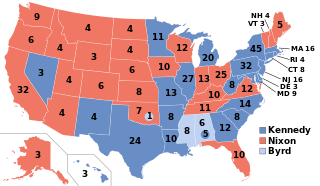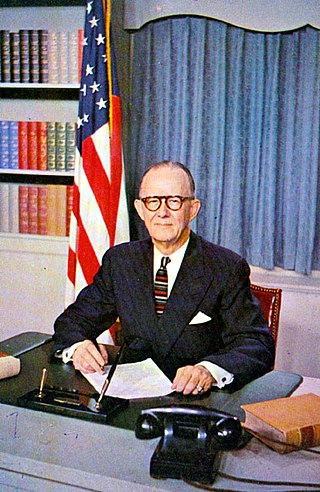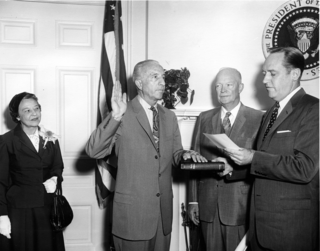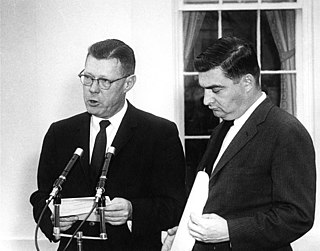Related Research Articles

Dwight David Eisenhower, nicknamed Ike, was an American military officer and statesman who served as the 34th president of the United States from 1953 to 1961. During World War II, he was Supreme Commander of the Allied Expeditionary Force in Europe and achieved the five-star rank as General of the Army. Eisenhower planned and supervised two of the most consequential military campaigns of World War II: Operation Torch in the North Africa campaign in 1942–1943 and the invasion of Normandy in 1944.

The 1956 United States presidential election was the 43rd quadrennial presidential election. It was held on Tuesday, November 6, 1956. Incumbent Republican President Dwight D. Eisenhower and his running mate, incumbent Vice President Richard Nixon, were re-elected, defeating for a second time Democrat Adlai Stevenson II, former Illinois governor. This election was the sixth rematch in American presidential history, a situation which did not occur again until 2024. It was the second time in which the winner was the same both times, the first being William McKinley's victories over William Jennings Bryan in 1896 and 1900. This was the last election before term limits established by the 22nd Amendment, which first applied to Eisenhower, became effective.

The 1960 United States presidential election was the 44th quadrennial presidential election, held on Tuesday, November 8, 1960. In a closely contested election, Democratic Senator John F. Kennedy defeated the incumbent Republican Vice President Richard Nixon. This was the first election in which 50 states participated, marking the first participation of Alaska and Hawaii, and the last in which the District of Columbia did not. This made it the only presidential election where the threshold for victory was 269 electoral votes. It was also the first election in which an incumbent president—in this case, Dwight D. Eisenhower—was ineligible to run for a third term because of the term limits established by the 22nd Amendment.

Thomas Dudley Cabot was an American businessman. He also became the U.S. Department of State's Director of Office of International Security Affairs.

Robert Bernard Anderson was an American administrator, politician, and businessman. He served as the Secretary of the Navy between February 1953 and March 1954. He also served as the Secretary of the Treasury from 1957 until 1961, and was one of President Dwight Eisenhower's closest confidants.

Milton Stover Eisenhower was an American academic administrator. He served as president of three major American universities: Kansas State University, Pennsylvania State University, and Johns Hopkins University. He was the youngest brother of, and advisor to, U.S. President Dwight D. Eisenhower.

Lawrence Brooks Hays was an American lawyer and politician who served eight terms as a Democratic member of the United States House of Representatives from the State of Arkansas from 1943 to 1959. He was also a president of the Southern Baptist Convention.

The Dwight D. Eisenhower Presidential Library, Museum and Boyhood Home is the presidential library and museum of Dwight David Eisenhower, the 34th president of the United States (1953–1961), located in his hometown of Abilene, Kansas. The museum includes Eisenhower's boyhood home, where he lived from 1898 until being appointed to West Point in 1911, and is also the president's final resting place. It is one of the thirteen presidential libraries under the auspices of the National Archives and Records Administration (NARA).

Wilton Burton "Jerry" Persons was an American military officer who served as the White House Chief of Staff to President Dwight D. Eisenhower from October 7, 1958, until January 20, 1961.

James Campbell Hagerty served as the eighth White House Press Secretary from 1953 to 1961 during the Presidency of Dwight D. Eisenhower. He was known for providing much more detail on the lifestyle of the president than previous press secretaries; for example, he covered in great detail Eisenhower's medical condition. Most of the time, he handled routine affairs such as daily reports on presidential activities, defending presidential policies, and assisting diplomatic visitors. He handled embarrassing episodes, such as those related to the Soviet downing of an American spy plane, the U-2 in 1960. He handled press relations on Eisenhower's international trips, sometimes taking the blame from a hostile foreign press. Eisenhower often relied on him for advice about public opinion, and how to phrase complex issues. Hagerty had a reputation for supporting civil rights initiatives.

Richard Nixon served as the 37th president of the United States from 1969 to 1974. He previously served as the 36th vice president of the United States from 1953 to 1961, and as a United States senator from 1950 to 1953 and United States representative from 1947 to 1950.
Raymond Joseph Saulnier was an American economist who served as the chairman of the Council of Economic Advisers from 1956 to 1961 under President Dwight D. Eisenhower.

Stephen H. Hess is a senior fellow emeritus in the Governance Studies program at the Brookings Institution. He studies media, the U.S. presidency, political dynasties and the U.S. government. He first joined Brookings in 1972 and was distinguished research professor of media and public affairs at the George Washington University (2004–2009). He served on Presidents Dwight D. Eisenhower and Richard Nixon's White House staff and as an adviser to Presidents Gerald R. Ford and Jimmy Carter.
The U.S. Council on Foreign Economic Policy (CFEP) was a high-level organization created by President Dwight D. Eisenhower in December 1954 to coordinate the development of the foreign economic policy of the United States.
Max Franklin Millikan was an American economist, Professor of Economics at MIT, assistant director of the Office of Research and Reports at the CIA, and director of the MIT Center for International Studies.

Mary Lillian Josephine Brown was an American radio and television producer, university administrator and instructor, author, makeup artist and image consultant. She provided makeup and image services to nine Presidents of the United States from Dwight Eisenhower to Bill Clinton, and to Martin Luther King Jr.

The presidential transition of Richard Nixon began when he won the 1968 United States presidential election, becoming the president-elect, and ended when Nixon was inaugurated on January 20, 1969. Nixon had become president-elect once the election results became clear on November 6, 1968, the day after the election. This was the first presidential transition to take place following the passage of the Presidential Transition Act of 1963.

The presidential transition of John F. Kennedy began when he won the 1960 United States presidential election, becoming the president-elect of the United States, and ended when Kennedy was inaugurated on January 20, 1961. Kennedy had become president-elect once the election results became clear on November 9, 1960, the day after the election.

The presidential transition of Dwight D. Eisenhower began when he won the United States 1952 United States presidential election, becoming the president-elect, and ended when Eisenhower was inaugurated on January 20, 1953.
References
- ↑ "Presidential transitions / Laurin L. Henry". trove.nla.gov.au. Trove. Retrieved 9 June 2021.
- 1 2 3 4 5 6 7 8 9 "HENRY, LAURIN L.: Papers re Presidential Transitions, 1952-1961" (PDF). www.eisenhowerlibrary.gov. Dwight D. Eisenhower Library. November 2002. Retrieved 8 June 2021.
- 1 2 3 4 5 6 7 8 9 "Laurin L. Henry Personal Papers | JFK Library". www.jfklibrary.org. John F. Kennedy Presidential Library. Retrieved 9 June 2021.
- 1 2 3 4 5 6 7 8 9 "His career shaped the government". The Daily Journal. 2 March 2019. Retrieved 8 June 2021.
- 1 2 3 4 5 6 "Laurin L. Henry, Ph.D." Marquis Who's Who Top Educators. 2019-01-14. Retrieved 9 June 2021.
- 1 2 "Prof. Laurin Henry '42 "Helped to Make a Bit of American History"". DePauw University. 3 March 2019. Retrieved 8 June 2021.
- ↑ Laurin L. Henry. Presidential Transitions. 1960. Menasha, Wisconsin. George Banta Company, Inc. p. x
- 1 2 "Push to Ease Presidential Transition" . Newspapers.com. The Courier-News (Bridgewater, New Jersey). Associated Press. 8 Nov 1960. Retrieved 19 May 2021.
- ↑ "Nixon, Richard – Transition Expenditures: General Accounting Office Audit (2)" (PDF). www.fordlibrarymuseum.gov. Comptroller General of the United States. 16 November 1970. Retrieved 6 February 2021.
- ↑ Dews, Fred (9 November 2016). "What Brookings did for the 1960 presidential transition". Brookings. Retrieved 5 February 2021.
- ↑ Brauer, Carl M. (1986). Presidential Transitions: Eisenhower Through Reagan. New York: Oxford University Press. p. xv. ISBN 0195040511.
- ↑ "The Department of Political Science Prize Winning Dissertations" (PDF). political-science.uchicago.edu. University of Chicago Department of Political Science. Retrieved 9 June 2021.
- ↑ "Laurin Luther Henry". Who's Who Lifetime Achievement. 2018-09-16.